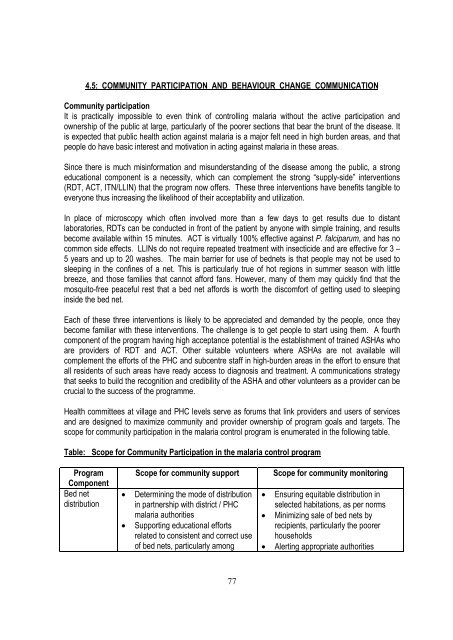training module for medical officers primary health centre - NVBDCP
training module for medical officers primary health centre - NVBDCP
training module for medical officers primary health centre - NVBDCP
- No tags were found...
Create successful ePaper yourself
Turn your PDF publications into a flip-book with our unique Google optimized e-Paper software.
4.5: COMMUNITY PARTICIPATION AND BEHAVIOUR CHANGE COMMUNICATIONCommunity participationIt is practically impossible to even think of controlling malaria without the active participation andownership of the public at large, particularly of the poorer sections that bear the brunt of the disease. Itis expected that public <strong>health</strong> action against malaria is a major felt need in high burden areas, and thatpeople do have basic interest and motivation in acting against malaria in these areas.Since there is much misin<strong>for</strong>mation and misunderstanding of the disease among the public, a strongeducational component is a necessity, which can complement the strong “supply-side” interventions(RDT, ACT, ITN/LLIN) that the program now offers. These three interventions have benefits tangible toeveryone thus increasing the likelihood of their acceptability and utilization.In place of microscopy which often involved more than a few days to get results due to distantlaboratories, RDTs can be conducted in front of the patient by anyone with simple <strong>training</strong>, and resultsbecome available within 15 minutes. ACT is virtually 100% effective against P. falciparum, and has nocommon side effects. LLINs do not require repeated treatment with insecticide and are effective <strong>for</strong> 3 –5 years and up to 20 washes. The main barrier <strong>for</strong> use of bednets is that people may not be used tosleeping in the confines of a net. This is particularly true of hot regions in summer season with littlebreeze, and those families that cannot af<strong>for</strong>d fans. However, many of them may quickly find that themosquito-free peaceful rest that a bed net af<strong>for</strong>ds is worth the discom<strong>for</strong>t of getting used to sleepinginside the bed net.Each of these three interventions is likely to be appreciated and demanded by the people, once theybecome familiar with these interventions. The challenge is to get people to start using them. A fourthcomponent of the program having high acceptance potential is the establishment of trained ASHAs whoare providers of RDT and ACT. Other suitable volunteers where ASHAs are not available willcomplement the ef<strong>for</strong>ts of the PHC and sub<strong>centre</strong> staff in high-burden areas in the ef<strong>for</strong>t to ensure thatall residents of such areas have ready access to diagnosis and treatment. A communications strategythat seeks to build the recognition and credibility of the ASHA and other volunteers as a provider can becrucial to the success of the programme.Health committees at village and PHC levels serve as <strong>for</strong>ums that link providers and users of servicesand are designed to maximize community and provider ownership of program goals and targets. Thescope <strong>for</strong> community participation in the malaria control program is enumerated in the following table.Table: Scope <strong>for</strong> Community Participation in the malaria control programProgramComponentBed netdistributionScope <strong>for</strong> community supportDetermining the mode of distributionin partnership with district / PHCmalaria authoritiesSupporting educational ef<strong>for</strong>tsrelated to consistent and correct useof bed nets, particularly amongScope <strong>for</strong> community monitoringEnsuring equitable distribution inselected habitations, as per normsMinimizing sale of bed nets byrecipients, particularly the poorerhouseholdsAlerting appropriate authorities77
















